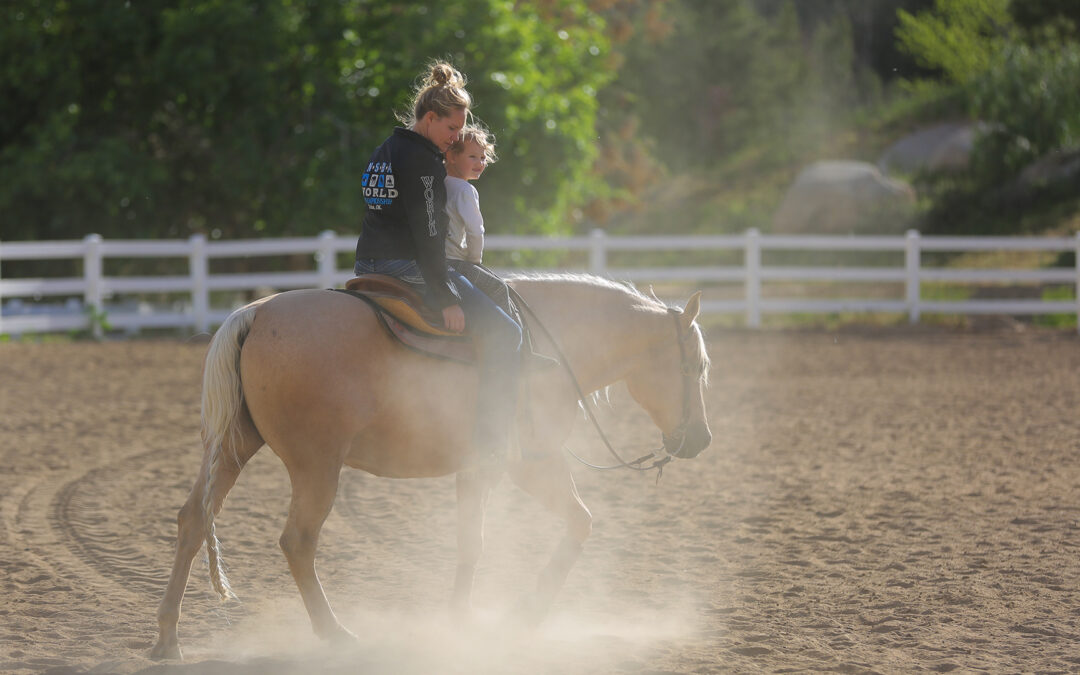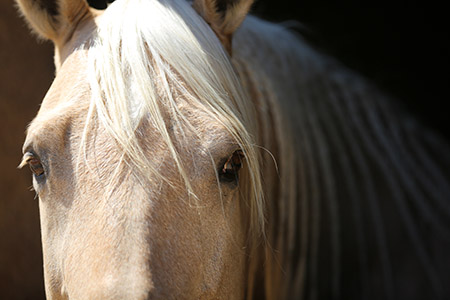Are you a timid rider? I believe that most of us at some time or another have moments of feeling timid, hesitant, or afraid on a horse. In certain situations and on certain horses, there may be times when it is wise to be hesitant or timid. Your intuition may be telling you to back off! However, there may be other times when your timidity turns into fear and you freeze or give wrong signals to your horse. You may even be unconsciously telling your horse that you are afraid, giving him the upper hand. When you give a fearful response over and over, he may learn to be spooky or naughty!
I have tips that will help you to master your fears and insecurity. These tips will also help you to gain a better relationship with your horse.
1. Identify Why You are Afraid or Timid
I feel that it is very important to honestly evaluate or assess yourself as a rider. Also look at why you may be struggling with being timid or fearful. Search yourself and do your best to be totally honest about yourself. I recommend you get some feedback from someone that you trust, especially if you are hard on yourself or do a lot of negative self-talking. People often don’t see themselves clearly. Sometimes just identifying your strengths and weaknesses will help you to overcome them. When you are not aware or mindful of them, you can’t work on them.
If you struggle with fear, ask yourself why. You may have had a bad experience that is haunting you, or you may be honestly intimidated by the size of a horse. You may just have had so many bad experiences that they outweigh the positive confidence building ones in your mind. Research has shown that a negative experience will impact you and stay with you longer than a positive one. So give yourself a lot of positive experiences to overcome the negative ones.
2. Become Aware of What Your Body Does as You Tense Up
When you become tense mentally, your body will also exhibit signs of tension. Your horse will definitely be able to feel subtle and significant changes in your body. I often teach people that a horse is full of moveable joints and parts, as well as your human body. One of your goals in becoming a confident rider is to be able to move and flow with your horse. When you tense up, your body will usually resist the horse’s movement and energy flow, and interfere or move against your horse. This is very uncomfortable for your horse. Think of it from the horse’s perspective. If you and your horse are moving together, you are catching his rhythm. Then all of a sudden, you see something before he does that might spook him. You then may: 1. Stop your breathing or take short, shallow breaths 2. Tense your seat and stop moving with your horse 3. Lean forward or 4. Tense up through your hands or grab his mouth.
Your horse feels your fear through your body, and your body signals are like a loud alarm going off that danger is near. He may then see that “boogie man” and believe you that it is scary. He will then spook, just as you feared he would. You told him in a lot of ways that he was unsafe. This is how riders can teach or program their horses to spook! The next time you tense up your body, your horse is looking for danger. Here are some tips to help control your body signals when you feel yourself tensing up:
A. Stay Breathing
Take deep, full breaths and breath using your diaphragm. Many times you can breathe your way past a potential spook or steady your nervous horse in a class at a show. When you continue with rhythmic breathing, you build his confidence and reinforce that he needs to listen to you. Deep, full breathing also keeps your spine and hips in the correct position on your horse.
B. Stay Moving with Your Pelvis
Focus on your horse’s rhythm, and unlock your seat to stay moving with him.
If he were to jump or spook and your seat were locked, you would have more of a chance of losing your balance. If you are flowing with your horse, your body will stay in the middle of him much easier.
C. Keep Your Hands Relaxed
I was once taught a trick that if you close your thumb and forefinger together, it will keep your hands relaxed and soft. Do your best to avoid tensing with your hands. Of course, if you need to hang on, do so… but keep your hands and their reactions separate from your body!
3. Make Sure You Have the Right Horse For You
A. Check Your Personality With Your Horse’s Personality
After you have given thought to your own abilities, also consider your personality type. Are you nervous or patient and slow? Fast thinking and reactive people can often make fast thinking horses nervous. Horses, just like people, have a variety of personality types, energy levels, and confidence levels! Take a look at your horse and yourself, and see if you are a good match.
B. Check Your Level of Experience With Your Horse’s Level of Experience
It’s often said a green horse and a green rider aren’t a good match. A green rider will usually do better with an older, more experienced, confidence building horse. It can be a disaster if the personality types are a mismatch as well! If you are a timid, inexperienced rider, don’t pick a jumpy, reactive, green horse. If you are determined to choose a green horse due to your spending budget, or if you just want the experience, choose a slow thinking, slow reacting, willing horse. One that is not too dull or too sensitive. Horses like people can be extremely sensitive and thin skinned, or they can be thick skinned and dull!
The better suited you are with your horse, the more success you will have!
4. How to Tell When to Back Off
In this article, my goal is to teach you to become more aware of yourself, your ability, and your own body, as well as to give you tools to help you gain control of your horse. I also want to impart to you the importance of knowing when to back off. If your horse feels like he is going to blow up, or you are losing control of where his feet are underneath you, you need to protect yourself. If my horse feels really high, I will get off and lunge my horse. If you don’t know what to do, or feel out of control, seek the help of a professional.
5. How To Regain Control
Here is one exercise that is extremely helpful. It is called “Follow The Nose” . I do this exercise often and if I have a difficult or scared horse, I will practice it a lot – even when he’s not scared. By doing this, it becomes a place of familiarity to him when he is scared. It is helpful because it puts your horse in a circle, and circles are very relaxing to your horse. It also allows you to regain control of his steps and his face because you are asking him to bend his head and neck, and step forward. It will also allow you to regain control of your horse’s attention and his feet. It redirects his mind towards you and your cues, and reminds him that you are in control!
Start the exercise by riding two handed and ask him with a direct rein cue to bend his head to one side. Use your hand soft and draw or pull without bumping if possible. Your direction of pull should be out to the side as if you were bringing your hand to the center of where his circle would be. Notice as you ask him to walk forward if he is stepping up and forward to his face. Many horses will drift out or cut in and try to make their own circle. Just reposition your hand accordingly to ask him to step up and forward. If he sucks back or refuses, just open up the circle and encourage him forward. I can tell if my horse is drifting or leaning if I start in one place and he takes me to another. Set a 10 or 15 foot circle in your mind and ask his body to stay on it. That is the secret to this exercise. Once he will let you drive and control his steps, he will usually relax. It puts you back in control. It should never be done in a punishing, angry manner, but rather that you are taking his face and body and directing his steps. It takes his mind off of what is bothering him and puts you back in control.
5. How to Gain Confidence
A. Visualize Yourself In Control. If you have an intimidating or scary situation, visualize yourself getting through it with great success!
B. Use Wisdom and be cautious. If you aren’t comfortable, don’t do it! Don’t let fear run you, but always use wisdom!
C. Set yourself up with a horse that will build your confidence.
D. Set yourself up for a good ride by making sure your horse is tired enough to think about working!
E. Use positive self talk! Coach yourself, tell yourself you can do it. Don’t ever put yourself down.
F. Pick a coach or trainer who is reassuring, gentle, and uses wisdom in when to push you and when to back off.
G. Practice controlling your body. Remember your seat, your breathing, finding the horse’s rhythm, and keeping your hands soft and light.
I hope these tips help you to become the best rider that you can be! If you would like to learn more about becoming a more confident rider, please check out our “Take Control” training DVD series available at www.westernhorsetrainingvideos.com!


